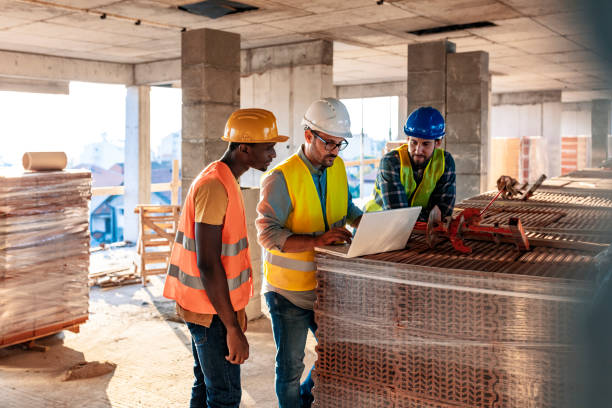What Industry Is Construction
Construction is derived from Latin words (com- “together” and struere “to pile up”), which refers to the art and science of forming items, systems, or organizations. The verb construct refers to the act of building, whereas the noun construction refers to the way something is built and the type of its structure.
Construction, in its most common sense, refers to the processes involved in constructing buildings, infrastructure, industrial facilities, and related operations from conception to completion. Construction normally begins with planning, finance, and design and continues until the asset is finished and ready for use; it also includes repairs and maintenance, any expansion, extension, or improvement work, and the asset’s final deconstruction, dismantling, or decommissioning.
Construction is a large sector that encompasses a wide range of construction and civil engineering vocations. Carpentry, road building, bridge development, and home design are all jobs in the construction business. Because it is responsible for building the infrastructure for cities, communities, and countries, this industry is one of the largest in the world.
The Construction Industry
Construction, an industry present in every developmental activity, is one important sector of the economy that is attracting increased attention as a prospective area for the development of improved institutional structure in emerging nations. Construction aids economic development by achieving some of the most basic development goals, such as output generation, job creation, income generation, and re-distribution. It also contributes significantly to meeting fundamental physical and social necessities, such as shelter, infrastructure, and consumer goods.
Construction is a major industry in all market economies around the world. It is the first indicator of the economy’s health. Its acceleration kicks off a wave of economic expansion and vice versa. Korea, Taiwan, and Hong Kong have all exploited the building industry to boost their economies. Malaysia and China are following a similar plan, upgrading their cities, motorways, and other infrastructure in order to become important players in the global economy.
Major Types of Construction
Residential, institutional, and commercial construction, specialized industrial construction, infrastructure, and heavy construction are the four major types of construction.
1. Residential Building
Residential housing construction is the first form of construction, and it entails the construction, maintenance, and remodeling of structures for the purpose of housing people, supplies, or equipment. Apartments, town homes, condos, nursing homes, and dorms are all included. Garages and outbuildings, such as utility sheds, are also considered residential structures.
Residential construction, as previously stated, also entails the maintenance and installation of utilities such as water and electricity throughout the structure. Residential housing projects are typically designed by engineers and architects, with construction carried out by construction companies that hire subcontractors to complete the project’s mechanical, structural, and electrical work.
In the case of single-family homes, however, builders often handle all parts of the project, including design and construction.
2. Institutional and Commercial Building
Schools, sports arenas, commercial centers, hospitals, stadiums, retail stores, and skyscrapers are examples of this sort of development. Institutional and commercial construction, like residential housing development, entails both the construction of new structures as well as the repair and upkeep of existing facilities. A firm or a private owner typically commissions a project like a retail store. Other infrastructure projects, such as stadiums, schools, and medical facilities, are frequently funded and controlled by both local and national governments.
4. Specialized Industrial Construction
The third form of construction is specialized industrial construction, which comprises constructing structures that necessitate a high level of specialization as well as technical planning, construction, and design skills. This form of construction is usually done by for-profit or industrial businesses. A chemical company, for example, can create oil refineries, and a power generation industry can construct nuclear power plants and hydroelectric power plants, both of which are specialized industrial structures.
5. Infrastructure and Heavy Construction
Infrastructure and heavy construction is the last form of construction, which includes the construction and updating of railways, communications, and roads, as well as railways to the city’s environs and current building construction. This type of development is frequently carried out by government organizations and major commercial enterprises in the public interest. Tunnels, bridges, highways, transport systems, drainage systems, and pipelines are examples of other projects that fall under this category.
Importance of The Construction Industry
Any changes to the structure of a property or infrastructure is handled by a professional in the construction industry. Construction can be either generic or civil engineering-based. The Construction Industry is responsible for the construction of dams, roads, monuments, wooden structures, real estate assets, and other structures.
Construction is an essential industry that contributes significantly to a country’s economic progress. Construction is an essential industry that contributes significantly to a country’s economic progress. The construction industry is responsible for laying the physical and technological foundations for modern civilization. It also creates investment opportunities in a variety of connected areas, which is critical to achieving national socioeconomic goals.
The construction industry is an investment-driven industry in which the government is very interested. The government enters into contracts with the construction industry to build infrastructure in the health, transportation, and education sectors. Construction industry is crucial for any country’s economy.
The most prevalent factor in our lives is construction. There is no element of human existence and civilization that the construction does not have a great impact on, not only in terms of physical space but also in terms of people’s hearts, by bringing them together in their social, cultural, political, recreational, and economic pursuits.
It encompasses a wide range of human activities, from huts to skyscrapers, from cart routes to super-express highways, from culverts to multi-span multilane flyovers, from village shops to supermarkets and large industrial complexes, refineries and fertilizer plants, and from observation posts in the high Himalayas to deep sea off-shore drilling platforms.
Conclusion
These are the most common types of structures in use today. Depending on the scope of your project, you can choose from a variety of building experts. An architect or engineer can assist you with the design of your structure, while a builder can assist you with the construction. Simply ensure that the person or contractor is credible, trustworthy, and knowledgeable in his field. You can find a good professional for your project by using the internet and referrals from friends and relatives.




